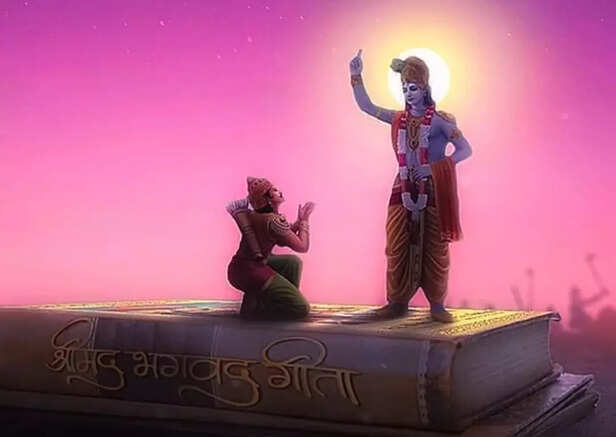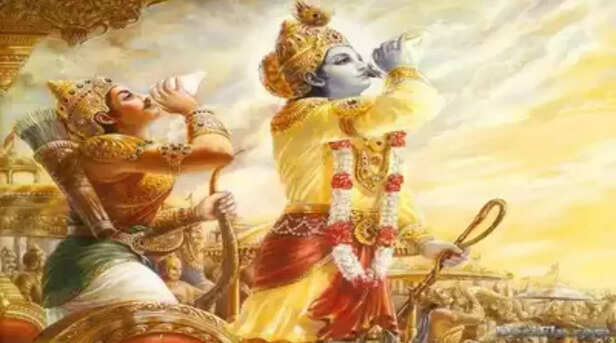By Letting Go of Attachment to the Fruits of Actions, a Yogi Attains Uninterrupted Peace—Bhagavad Gita 5.12
Ankit Gupta | May 24, 2025, 22:23 IST
( Image credit : Timeslife )
Shri Krishna’s message to Arjuna is universal: you don’t need to renounce the world—you need to renounce the grip the world has on your heart. It is not the sword in Arjuna’s hand that creates bondage, but the fear in his mind.
"Yuktah karma-phalam tyaktva shantim apnoti naishthikim;
Ayuktah kama-karena phale sakto nibadhyate."
The one who is united (Yukta), having abandoned attachment to the fruits of action, attains steady peace. But the one who is not united (Ayukta), driven by desire and attached to results, becomes bound.

The scene is Kurukshetra. Armies are assembled. The air is thick with tension. But before a single arrow is fired, a deeper battle unfolds—a war within the heart of Arjuna. Caught between dharma and despair, action and inaction, Arjuna lowers his bow. And it is in this moment of breakdown that the eternal teaching of the Bhagavad Gita is born.
In Shloka 5.12, Shri Krishna offers Arjuna—and through him, all of humanity—a powerful formula: the secret to inner freedom is not in inaction, but in non-attachment. This shloka reveals a timeless truth: the cause of suffering is not what we do, but how attached we are to what we expect from it.
Shri Krishna introduces two psychological profiles—Yukta and Ayukta. These are not merely theological terms but reflections of the inner state with which we live and act.
A Yukta is someone who is aligned with the Divine, aware of their deeper Self. This person performs every action with focus, excellence, and devotion—but without inner obsession over the outcome. Success or failure, praise or blame, gain or loss—all are accepted with equanimity. The Yukta has no mental residue after action, and therefore, dwells in peace.
“He acts, but is not acted upon.”
He lives in the world, but the world does not live in him.
In contrast, the Ayukta is disconnected from the Divine Self. Every action is fueled by desire, ambition, fear, or ego. For the Ayukta, results are everything. Success inflates the ego. Failure wounds it. The Ayukta becomes entangled in karmic reactions, oscillating between excitement and anxiety, attachment and aversion.
“He is not acting, but reacting.”
Life becomes a chain of cravings and frustrations.
This is the psychological trap most of us live in today.
One of the most misunderstood teachings of Indian spirituality is the idea that action creates bondage. This is only partially true. The Gita refines the idea by clarifying that it is not action itself, but the attachment to results that binds the soul.
Let’s take two examples:
A mother feeds her hungry child, not for praise or reward, but out of love. Her action leaves no residue of pride or expectation. She forgets the act soon after. She is Yukta.
The same act—feeding—when performed for selfish gain or image-building, is riddled with inner calculations. Every photograph taken, every headline printed, tightens the karmic web. The result becomes the driver, not the act itself. He is Ayukta.
Same action. Different intent. Different karma.
In today’s world, everything is measured by outcome: marks, salaries, likes, followers, awards. We are conditioned from childhood to believe that we are only as good as our results. This breeds anxiety, fear of failure, and burnout.
But the Bhagavad Gita teaches a different path.
“Let go of the fruit, not the effort.”
True mastery is when you work with full heart but without the chains of craving.

Let’s return to Arjuna’s dilemma. When he sees his relatives and teachers on the battlefield, he refuses to fight. He fears the consequences—what if victory comes at the cost of bloodshed? What if failure brings shame?
Krishna gently guides him: “You are grieving not for the action, but for your imagined result. Your fear is not about dharma, but about the fruit of your action.”
He then reveals this powerful truth:
"Karmaṇy-evādhikāras te mā phaleṣhu kadāchana..."
(You have a right to perform your prescribed duties, but not to the results.)
This is not a call to detachment from life, but to detachment within life.
Detachment (Vairagya) is often misunderstood as indifference or emotional coldness. In reality, true detachment is love without obsession, effort without stress, and surrender without passivity.
Imagine an archer. His job is to focus on his form, grip, aim, and release. If he is obsessed with the bullseye before letting the arrow go, he may falter. But if he perfects the process, the result will take care of itself.
Focus on your dharma. Let the Divine take care of the fruit.
This was the Gita’s spiritual archery lesson to Arjuna.
When we let go of the fruit, something magical happens—inner peace arises.
In Gita's karmic algebra, we can create a simple formula:
Karma Yoga = Action – Attachment
This path leads to freedom from karma-bandhana (bondage of action). It is not about escaping action, but acting with spiritual clarity.
You can still:
The Yukta does not think, “I am doing this.”
He feels, “I am being used as an instrument.”
This is what Krishna later says in Gita 11.33:
“Nimitta matram bhava savyasachin”
(Become merely an instrument, O Arjuna.)
This shift from “I am the doer” to “I am the Divine's vehicle” is the true transformation.
Here are some ways to internalize this teaching:
Before beginning your work, say mentally:
“Whatever I do today is my offering to the Divine.”
At night, reflect:
Repeat this when you feel anxious about outcomes. It will center you in the spirit of Karma Yoga.
The world will always fluctuate. Results will come and go. But the one who lives as a Yukta remains untouched, rooted in inner silence.
Shri Krishna’s message is simple, yet revolutionary:
You don’t need to change what you do.
You need to change how you relate to what you do.
When action becomes devotion and outcome becomes surrender, life becomes meditation. This is freedom from entanglement. This is the path to true peace.
Ayuktah kama-karena phale sakto nibadhyate."
The one who is united (Yukta), having abandoned attachment to the fruits of action, attains steady peace. But the one who is not united (Ayukta), driven by desire and attached to results, becomes bound.
The Battlefield Within

Deeper battle unfolds
( Image credit : Pixabay )
The scene is Kurukshetra. Armies are assembled. The air is thick with tension. But before a single arrow is fired, a deeper battle unfolds—a war within the heart of Arjuna. Caught between dharma and despair, action and inaction, Arjuna lowers his bow. And it is in this moment of breakdown that the eternal teaching of the Bhagavad Gita is born.
In Shloka 5.12, Shri Krishna offers Arjuna—and through him, all of humanity—a powerful formula: the secret to inner freedom is not in inaction, but in non-attachment. This shloka reveals a timeless truth: the cause of suffering is not what we do, but how attached we are to what we expect from it.
The Two Types of Actors: Yukta vs. Ayukta
Yukta – The Aligned Yogi
“He acts, but is not acted upon.”
He lives in the world, but the world does not live in him.
Ayukta – The Disconnected Doer
“He is not acting, but reacting.”
Life becomes a chain of cravings and frustrations.
This is the psychological trap most of us live in today.
Not Action, But Attachment Binds
Let’s take two examples:
1. A Mother Feeding Her Child
2. A Politician Feeding the Poor Before Elections
Same action. Different intent. Different karma.
Why Results Obsess Us: The Modern Disease
But the Bhagavad Gita teaches a different path.
“Let go of the fruit, not the effort.”
True mastery is when you work with full heart but without the chains of craving.
Arjuna's Inner Conflict

A Deeper Story
( Image credit : Times Life Bureau )
Let’s return to Arjuna’s dilemma. When he sees his relatives and teachers on the battlefield, he refuses to fight. He fears the consequences—what if victory comes at the cost of bloodshed? What if failure brings shame?
Krishna gently guides him: “You are grieving not for the action, but for your imagined result. Your fear is not about dharma, but about the fruit of your action.”
He then reveals this powerful truth:
"Karmaṇy-evādhikāras te mā phaleṣhu kadāchana..."
(You have a right to perform your prescribed duties, but not to the results.)
This is not a call to detachment from life, but to detachment within life.
What Detachment Really Means
- It does not mean you stop caring.
- It means you care so deeply that you release control.
- It means doing your best and letting go of the rest.
A Real-Life Analogy: The Archer and the Target
Focus on your dharma. Let the Divine take care of the fruit.
This was the Gita’s spiritual archery lesson to Arjuna.
Peace Is the Natural Result of Surrender
- The mind becomes still.
- The heart becomes light.
- We act with presence, not pressure.
- Life becomes a flow, not a fight.
The Karma Equation: Effort – Expectation = Liberation
Karma Yoga = Action – Attachment
This path leads to freedom from karma-bandhana (bondage of action). It is not about escaping action, but acting with spiritual clarity.
You can still:
- Run a business
- Lead a nation
- Raise a family
- Create art
- Fight injustice
The Shift of Identity
He feels, “I am being used as an instrument.”
This is what Krishna later says in Gita 11.33:
“Nimitta matram bhava savyasachin”
(Become merely an instrument, O Arjuna.)
This shift from “I am the doer” to “I am the Divine's vehicle” is the true transformation.
Daily Practices to Live Gita 5.12
1. Start the Day with an Offering
“Whatever I do today is my offering to the Divine.”
2. Practice Karma Journal
- Did I act with detachment?
- Where did I get disturbed by results?
- What can I surrender more tomorrow?
3. Use the Mantra: “I Act, God Decides”
The Path to Inner Sovereignty
Shri Krishna’s message is simple, yet revolutionary:
You don’t need to change what you do.
You need to change how you relate to what you do.
When action becomes devotion and outcome becomes surrender, life becomes meditation. This is freedom from entanglement. This is the path to true peace.
